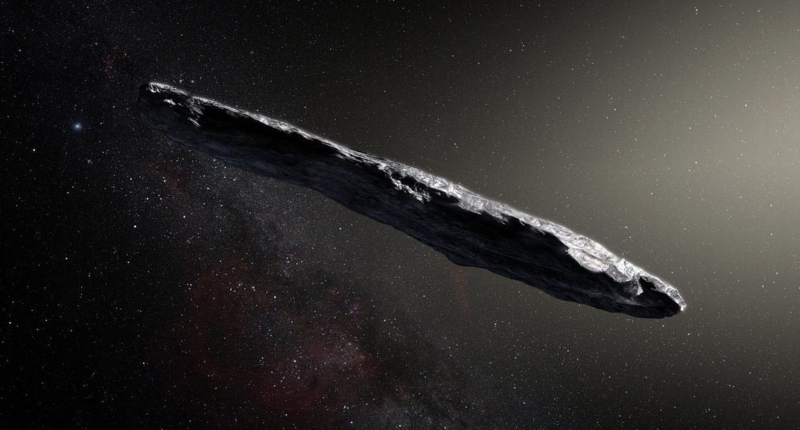Scientists have finally uncovered the explanation behind the mysterious appearance of ‘Oumuamua, a tiny comet that some thought could be an alien spaceship. Initially discovered in 2017, it had puzzled scientists due to its lack of visible dust cloud. However, researchers have found that cosmic radiation produced hydrogen on its surface, causing a slight acceleration. ‘Oumuamua was consistent with a standard interstellar comet that experienced heavy processing. The comet’s size played a significant role in the hydrogen production and acceleration. The top five keywords for this content are cosmic radiation, interstellar comet, ‘Oumuamua, hydrogen production, and acceleration.
Scientists Finally Unravel the Mystery of ‘Alien Spaceship’ ‘Oumuamua’
In 2017, when ‘Oumuamua was discovered moving away from the Sun, scientists were baffled by its unusual characteristics, with some speculating it could be evidence of an alien spaceship. The first-ever known visitor from outside our solar system was named ‘Oumuamua and had an unusual cylindrical shape.
Unlike other comets or asteroids, ‘Oumuamua did not have a visible dust cloud, which further puzzled scientists. In typical circumstances, a comet or asteroid would emit a bright tail caused by water and other molecules heating as it gets closer to the Sun. But ‘Oumuamua was too small and too far away from the Sun to have enough energy to eject gases that could produce the bright tail.
Cornell University’s Darryl Seligman said, “We had never seen a comet in the solar system that didn’t have a dust coma. So, the non-gravitational acceleration really was weird.” But scientists have finally uncovered a relatively simple explanation for ‘Oumuamua’s lack of visible dust cloud.
Astronomers have found that high-energy particles, similar to cosmic rays, produce hydrogen when they come into contact with ice. For a normal-sized comet, the hydrogen production was unlikely to make any significant impact, but in the case of ‘Oumuamua, which was relatively small and had a large surface area relative to its size, the hydrogen produced was enough to push it through the cosmos.
‘Oumuamua was roughly 115mx111mx19m in size, with a slight reddish color. Its name translates to “a messenger from afar arriving first” in Hawaiian. The mystery of the tiny comet, which scientists believed could be an alien spaceship, has finally been resolved thanks to the discovery of cosmic rays’ impact on hydrogen production.
Conclusion
Scientists have finally found the explanation behind the mysterious appearance of ‘Oumuamua, a tiny comet that some thought could be an alien spaceship. Its lack of visible dust cloud had puzzled scientists since its discovery in 2017. However, researchers have found that high-energy particles, similar to cosmic rays, produce hydrogen when they come into contact with ice, which was enough to propel ‘Oumuamua through the cosmos.
‘Oumuamua Explained: Comet Gets Cooked by Cosmic Radiation
Scientists have finally solved the mystery of ‘Oumuamua, the first known visitor from outside our solar system. Initially thought to be an alien spaceship due to its unusual characteristics, the tiny comet’s lack of visible dust cloud puzzled scientists. However, researchers have found that cosmic radiation produced hydrogen on the surface of ‘Oumuamua, causing a slight acceleration.
‘A comet traveling through the interstellar medium is basically getting cooked by cosmic radiation, forming hydrogen as a result. For a large comet, outgassing would only occur from a thin shell, making it difficult to detect any acceleration. However, because ‘Oumuamua was so small, researchers believe it produced sufficient force to power the acceleration.
‘Oumuamua was discovered in October 2017 by astronomers in Maui. The comet had a slight reddish color and was roughly 115mx111mx19m in size. UC Berkeley assistant professor of chemistry, Jennifer Bergner, stated that ‘Oumuamua is consistent with a standard interstellar comet that experienced heavy processing.
“The models we ran are consistent with what we see in the solar system from comets and asteroids. So, you could essentially start with something that looks like a comet and have this scenario work,” added Bergner.
Conclusion
Comet ‘Oumuamua’s mystery has been solved, with researchers finding that cosmic radiation produced hydrogen on its surface, causing a slight acceleration. This tiny comet, discovered in 2017, had puzzled scientists due to its lack of visible dust cloud. However, researchers believe that ‘Oumuamua is consistent with a standard interstellar comet that experienced heavy processing.
Don’t miss interesting posts on Famousbio








